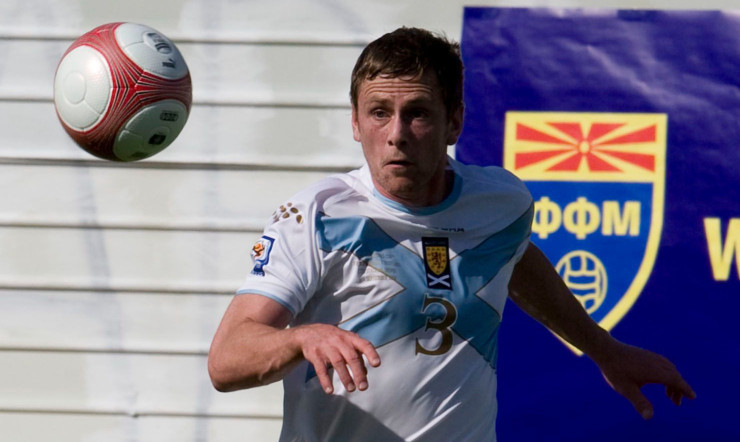
Scotland will aim to erase the memory of defeat by Belgium in Macedonia on Tuesday night.
One of the Tartan Army’s former favourites, though, will forever associate the eastern European country with the beginning of the end.
Gary Naysmith played in the baking heat of Skopje five years ago when George Burley’s side kicked off the 2010 World Cup qualifiers with a wounding defeat.
While both he and the manager stayed in place for a few ties more, by the time the focus switched to the bid to reach Euro 2012, they were gone.
“It was my last campaign as a Scotland player and unfortunately it never really got started,” recalls the 34-year-old former Everton and Hearts full-back.
“The game was played in intense heat. It was the start of September, same as this one, but it was in the middle of the afternoon.
“Conditions beforehand were so bad, we did our warm-ups in the shadow of the main stand.
“As soon as we stepped out, the heat hit us and I remember thinking: ‘Wow. We are going to have to play football in this!’
“Personally, I don’t go in for using the weather as an excuse. It is the same for both teams.
“It is just quite possible the reason they beat us was because they were better than us on the day!
“But I do remember it was very hard going. In heat like that, you struggle to catch your breath after making a run and that affects your natural game.
“We lost an early goal when our keeper Craig Gordon pushed a shot onto the post and one of their lads followed it in to score.
“After that, we never got back in the game and it finished 1-0.
“There was talk at the time the SFA shouldn’t have had us starting off there. We struggled in the campaign and George Burley ended up paying the price with his job.”
He wasn’t alone.
Burley’s successor, Craig Levein decided changes had to be made and he deemed that the nothing-if-not-reliable left-back was no longer required.
“That was disappointing,” admits Naysmith, who half a decade on is still playing, with League One club, East Fife.
“I was a Scotland player for nearly 10 years then nothing,” he continues. “You know nobody gets to play for their country for ever. I just thought it could have been handled better.
“I had 46 caps, and was a handful away from reaching 50 and getting myself into the SFA Hall of Fame.
“But I never even got a phone call about being left out.
“I am sure the manager had plenty of other things to be getting on with at the time. But that just ended things on a bit of a sour note for me.
“I loved my time playing with Scotland. It was the highlight of my career.
“And that kind of summed it up for me. For all the good times, there were certainly frustrations.
“When I was 27, someone counted up all the times I’d been forced to withdraw because of injury.
“It was calculated that if I had stayed fit throughout, I would have won 60-odd caps.
“Still, I will always be proud of the contribution that I did make.”
Current Scotland boss Gordon Strachan bid £1.5-million to take Naysmith from Hearts to Coventry City in the autumn of 2000.
But Everton came in with a higher offer and he became a first-team regular for seven years at Goodison.
Ever since, Gary has had an interest in Strachan’s managerial career, and is optimistic about the direction he is taking the country in.
“There are certain managers who can get players to run through a brick wall for them and Gordon is one of them,” Naysmith continues.
“He hasn’t been in charge of Scotland that long but already you get that feeling.
“The performance in Croatia was little short of incredible.
“Even if we hadn’t won the game, the players would have deserved huge praise for the effort they put in.
“It was a similar story at Wembley too. OK, we lost but it was more down to a lack of concentration at set-pieces than anything else.
“I think his gameplans play to our strengths.
“We perhaps don’t produce the most technically-gifted footballers in the world, but we will compete with anyone.
“And the system gives our creative guys like Robert Snodgrass, Shaun Maloney and Leigh Griffiths the opportunity to get at teams when the opportunity allows.
“James Morrison has taken his game to a whole new level since I played with him, and don’t forget we will get stronger when the two Fletchers, Darren and Steven, return.”
If Naysmith sounds a little like a manager when delivering his analysis, it is because that is exactly what he is in training to be.
He’s currently doing his UEFA Pro Licence, having already gained his A and B badges, and will be working with younger players at East Fife.
“I want to play as long as I can, but I’m moving towards coaching,” he says.
“Throughout my career I have been fortunate to work under some terrific managers Walter Smith, Alex McLeish, Jim Jefferies, Archie Knox, Craig Brown and David Moyes.
“And look how many of my team-mates from the Hearts Scottish Cup-winning team of 1998 have become bosses Davie Weir, John Robertson, Colin Cameron and Grant Murray. I’d be crazy not to give it a try sometime.”

Enjoy the convenience of having The Sunday Post delivered as a digital ePaper straight to your smartphone, tablet or computer.
Subscribe for only £5.49 a month and enjoy all the benefits of the printed paper as a digital replica.
Subscribe